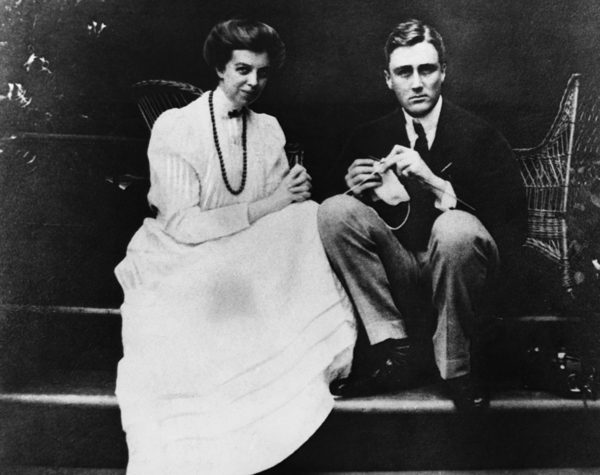By Jessica Grey
On this day, one hundred and thirty-five years ago, the Hyde Park branch of the esteemed Roosevelt family welcomed a new baby boy. That baby boy would go on to be one of the most influential figures—for better and for worse—of the twentieth century.

Named after his great uncle, Franklin Hughes Delano, FDR was born into a privileged life in 1882. He was the only child of the marriage between James Roosevelt and Sara Ann Delano—both from wealthy New York families. Roosevelt was afforded every advantage available. For example, he met President Grover Cleveland in the White House when he was five and attended the elite Groton School before going on to Harvard University. His parents took him to Europe a number of times, giving him the opportunity to become conversant in French and German (and to cultivate an early arrest record).
It was during his tenure at Harvard that his distant cousin, Theodore, was elected President of the United States. After completing his degree at Harvard, he and Eleanor became engaged, much to his overbearing mother’s chagrin, and he returned to New York to attend Columbia Law. One year into his law school career, on Saint Patrick’s Day, Franklin stood at the altar set up in the drawing room of a family member’s home, as President Teddy Roosevelt walked his favorite niece, Eleanor, down the aisle. He dropped out of law school a few years later after having already passed the bar exam (Columbia posthumously awarded him a Juris Doctor degree).

1906 — Eleanor and Franklin Roosevelt as a young couple. They were married March 17, 1905. — Image by © CORBIS The newlyweds playing with conventional gender norms.
In 1908, he was hired on at a prestigious New York law firm, handling mostly corporate law. His stint there was brief as he ran for, and won, New York State Senate in 1910, kicking off his political career. During his shortened second term as state senator, he chaired the Agriculture Committee, giving him experience that would prove valuable a few decades later. His second term ended up being only one year long, as he was appointed Assistant Secretary of the Navy by President Woodrow Wilson.

A fun, if only tangentially related, fact that is nevertheless super relevant to our interests: Roosevelt served as Assistant Secretary under Secretary Josephus Daniels, from whom (indirectly) we get the term “cup of joe.”
At this point, he and Eleanor had three surviving children. With the increasing social demands that came with Franklin’s ever more serious political career, Eleanor hired a social secretary—Lucy Mercer—with whom Franklin carried on an extramarital affair for years. Though the affair began in 1914, Eleanor did not discover it until 1918, after bearing two more children. After the affair had come to light, their marriage became a political partnership—though they remained married, they both pursued other romantic attachments.
He left his post as Assistant Secretary of the Navy in 1920 when he joined Governor James Cox’s presidential bid as the candidate for the vice presidency. After the failed campaign, Roosevelt was rebuked by Congress as the dust began to settle around the Newport Sex Scandal. Only a few weeks after the embarrassing run-in with Congress, FDR took ill while on vacation and was diagnosed with polio—though, more recent, and somewhat controversial, analyses suggest that he was stricken with Guillain-Barré syndrome, an autoimmune disease that attacks the peripheral nervous system. Regardless of the illness that struck him, 1921 saw Roosevelt mostly wheelchair-bound for the rest of his life.

After falling ill, Roosevelt retreated from public life for a while and, when he wasn’t seeking out various therapies he hoped would return the use of his legs, he focused on his law career and his hobbies. In pursuit of some helpful therapy, Roosevelt bought property in Warm Springs, Georgia; his exposure to the poverty of rural Georgia during his treks to and from Warm Springs significantly impacted his policies while in the White House.
He also spent many painful hours teaching himself to walk in short spurts with the assistance of iron braces. He felt it was necessary to convince everyone that his condition was improving before delving back into the public arena that is politics. As a result, he refused to use his wheelchair in public, and the above photograph is one of the very few he ever allowed to be taken. It was his 1924 speech to the Democratic convention nominating New York Governor Alfred Smith for the presidential candidacy that marked his return to public life.

It wasn’t until 1928 that Smith received the nomination for a presidential bid. As Smith embarked on his presidential campaign, he encouraged Roosevelt to run for governor—an election that FDR won by a one percent margin. Though he campaigned on very much the same progressive platform—though, decidedly intensified, thanks to the dire straits created by the Great Depression—, his reelection to the office was much less of a nail-biter. It was the programs that he established as governor to help New Yorkers cope with the Great Depression that garnered him the momentum needed for a presidential bid in 1932.
And the rest is history. Literally. There was much about Roosevelt’s presidency that made the history books, in part because so much of it was atypical. Most obviously, it was atypical in that he was elected President of the United States four times. FOUR! He’s the reason Congress codified the prior tradition of self-limiting presidential terms into law. Also exceptional was First Lady Eleanor Roosevelt’s involvement—she was the first First Lady to be so deeply, politically engaged in both FDR’s administration and her political agenda. And if we’re going to talk about things that made his presidency notable, I have to mention the sheer number of agencies and administrations he added to the federal government, garnering both praise and criticism. Though many them were dissolved by Congress after the Great Depression ended, several of his so-called alphabet soup agencies, like the SEC, FDIC, NLRB, and Social Security, are still active today.

His New Deal programs and agencies pulled the nation through the Great Depression and, as our allies became increasingly embroiled in World War II, Roosevelt kept folks in the U.S. working as we became the supplier of arms and sundry goods for our allies. We attempted to remain neutral while also supplying our allies (yeah, that sounds oxymoronic to me too)—and, tragically, callously turning away Jewish refugees fleeing Nazi persecution—until December 7, 1941, when Pearl Harbor was bombed, sinking the USS Arizona. As we were catapulted headlong into the war, President Roosevelt—in a move that seemed very much in line with the very ideologies we were fighting—ordered the internment of U.S. residents of Japanese descent—even those who were natural born citizens**.

With the end of the war in sight, President Roosevelt visited Warm Springs to rest and gather energy before the founding meeting of the United Nations. He died after suffering a cerebral hemorrhage on April 12, 1945. Vice President Harry Truman was officially sworn into the presidency, and the war in Europe ended less than a month later. Truman dedicated the victory to the memory of President Roosevelt. Interestingly, FDR did not have a close working relationship with Vice President Truman, and when Roosevelt died, Truman was in for a number of surprises, including the Manhattan Project, about which he knew nothing.

Roosevelt’s legacy is a complicated one—he was a progressive that strove to help folks so vulnerable to economic upheavals, but he also failed to sign the anti-lynching legislation. He outlined what he called the Second Bill of Rights which declared eight rights for all Americans, but he also imprisoned Japanese Americans and turned away Jews seeking asylum—both in the name of “national security.” And for better or worse, he presided over the United States’ emergence as a world power. In any case, there is no denying the profound impact Franklin Delano Roosevelt had on the nation and the world.
**Author’s note: if you haven’t seen Allegiance yet, I hope you will. I am in no way affiliated with the show; I just think it is an incredibly poignant piece of work right now. It will be shown at hundreds of theaters nationwide on February 19, 2017.






Leave a Reply